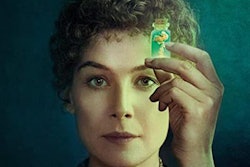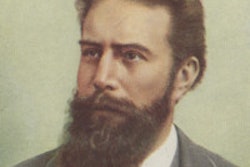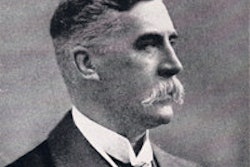
The year 1914 should have been the start of a new period in the scientific life of Marie Curie. Several years earlier it was decided a Radium Institute in Paris would be funded in order to facilitate research into radioactivity. The construction of the institute had been very slow, which caused Curie much frustration, but the building was finally completed in July 1914, two years after the initial agreement had been signed.
 A bust of Marie Curie by Josef Hilpert.
A bust of Marie Curie by Josef Hilpert.
The Sorbonne had contributed 400,000 French Francs towards the construction of the facility, which was located on the rue Pierre Curie. Curie had been involved in the design of the buildings, and especially the laboratories. The buildings consisted of double laboratories across a central courtyard where there was a garden, and she had included a gardener in the budget.
One of the laboratories would be devoted to medical and biological research using radioactivity and radium, and the other laboratory was to research the nature of radioactivity. However, all of this was to cease on 28 June 1914, when the Archduke Franz Ferdinand was assassinated and Europe was plunged into war.
Whilst the cost of building the Radium Institute was high, it was only a little more than the cost of a gram of the precious radium. Work could not continue because most of the able-bodied male staff was conscripted into the French army. Only an elderly mechanic who had heart disease was retained.
When three German bombs fell in Paris on 2 September 1914, the precious radium was seen to be in danger. At the request of the French government, Curie put the radium into a lead box and took it by train to Bordeaux, to where the government itself had moved from Paris. She placed it in a safe deposit box in a bank and returned to Paris on a military training. She said the French citizens on the Bordeaux train station were "surprised and comforted to learn of someone who found it natural to return to Paris."
 Marie Curie is shown during a visit to Ypres Cathedral.
Marie Curie is shown during a visit to Ypres Cathedral.Curie was aware of the extreme danger that her adopted country of France was in, and she later wrote that "the dominant duty imposed on everyone at that time was to help the country in whatever way possible during the extreme crisis that it faced .... It was left to each to take his own initiative and means of action. I therefore sought to discover the most efficient way to do useful work."
 A fleet of 20 x-ray vehicles was built up, and they were called "petites Curies."
A fleet of 20 x-ray vehicles was built up, and they were called "petites Curies."Curie's actions were characteristically energetic. She became aware of the beneficial effects that radiography would have in military surgery, and worked to put x-ray equipment in military hospitals. She had never worked with x-rays, although she had given lectures on them at her course of lectures held at the Sorbonne in Paris. There were few x-ray units available, and so she set about collecting apparatus.
 Marie Curie with her daughter, Irène, and other researchers in her laboratory at the Edith Cavell Hospital in 1914.
Marie Curie with her daughter, Irène, and other researchers in her laboratory at the Edith Cavell Hospital in 1914.The French government gave her the title of director of the Red Cross Radiology Service. During August and September 1914, she worked on developing stationary radiology units in hospitals, but she also became aware that mobile x-ray units would be helpful to bring radiography closer to battlefield casualties. She collected vehicles from wealthy contacts and also raised money. These vehicles were transformed into ambulance vans, which could be equipped with x-ray apparatus, including a generator.
 Radiology and War by Marie Curie.
Radiology and War by Marie Curie.
Ultimately a fleet of 20 vehicles was collected, and they were called petites Curies or "little Curies" by the French soldiers. Curie and a team of volunteers (including her daughter Irène, who was 17 when the war started) drove them to the front lines. The first radiology car was operational by October 1914.
Curie found it was also necessary to improve her knowledge, and so she studied technical books on radiology and radiology apparatus, and also anatomy books. She knew that apparatus was of little value without trained staff so she set up training in the Radium Institute with courses lasting six weeks for groups of 20 women. The course covered mathematics, physics, and anatomy. Her work was invaluable, and she said that, "The use of the x-rays during the war saved the lives of many wounded men; it also saved many from long suffering and lasting infirmity."
Curie worked tirelessly for France and she wrote in a letter to Paul Langevin on 1 January 1915, "I am resolved to put all my strength at the service of my adopted country, since I cannot do anything for my unfortunate native country (Poland) just now, bathed as it is in blood after more than a century of suffering."
Her life remains an inspiration.
Dr. Adrian Thomas is chairman of the International Society for the History of Radiology and honorary librarian at the British Institute of Radiology.
Reference
Pasachoff N. Marie Curie and the Science of Radioactivity. Oxford: Oxford University Press; 1996.
The comments and observations expressed herein do not necessarily reflect the opinions of AuntMinnieEurope.com, nor should they be construed as an endorsement or admonishment of any particular vendor, analyst, industry consultant, or consulting group.



















